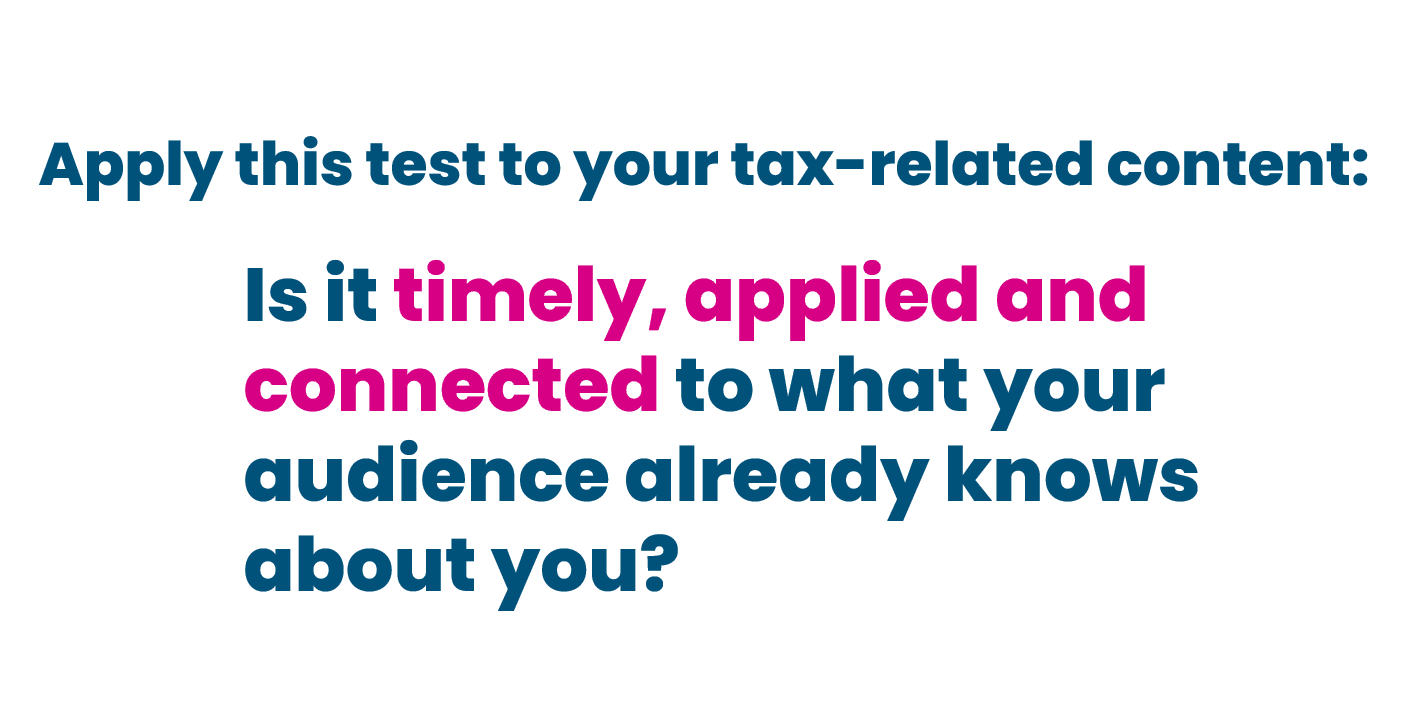
A little inspiration for writing about investor tax topics
Key takeaways:
- Test your tax content by asking whether it’s timely, applied and connected to what your audience already knows about you
- You can apply this way of thinking even when much is uncertain
- Look for opportunities to preview change then be quick to comment on it when it transpires
There’s so much happening in government right now that even something as big as the renewal or sunsetting of the 2017 tax cuts isn’t getting a ton of attention. Over time that will change, because for individual investors, taxes are always relevant and often timely. Wealth managers and others preparing content for investors understand this; they know their audience and write for it. But doing so is harder when everything—even the income tax itself?!—is so uncertain.
A wealth strategist we’ve worked with has one of the best ways we’ve seen of approaching tax-related content. It’s an approach that focuses on the firm’s audience but also keeps the media in mind:
- The basic pattern is to write a note ahead of an anticipated inflection point—say, a Congressional vote—that outlines the potential impacts on investors. Share that note with clients and the media.
- Then, have a second note ready to go the day of the vote. Here, summarize the original, speculative perspective, and augment it with more application.
- Send it promptly to clients, who may not study the details but are likely to appreciate knowing you’re paying attention. Use the note to underline aspects of your perspective (e.g., taking a long-term view; putting things in context of a holistic financial plan).
- Also send it to journalists. They may appreciate the details about a new rule or law, though they can also get those from even more specialized sources. What they can’t get from outside the investment industry is salient comments about the rule or law’s implications for investors.
Of course, you can implement any number of variations on this theme. Tracing throughout it are three broader ideas that you may find helpful when approaching tax topics for investors regardless of the specific communications pattern:
- Salient. Both relevant and timely for the audience.
- Applied. What’s the impact on investors, specifically?
- Connected. Linked to what your audience already knows about you—such as your investment philosophy.
The following table collects, along these dimensions, several tax-related articles we’ve written and/or edited over the years. Some of these we’ve also placed in media publications.
How to approach tax topics:
Timeliness, Application, Connection
| High-level topic | Approach | Timeliness | Application | Connection |
|---|---|---|---|---|
| Tax Cuts & Jobs Act | Previewing then revisiting | Prior to law’s finalization, then again upon its enactment | How each of the main components affects investors, either directly or indirectly | In-depth financial planning |
| Tax domicile | Exploring the implications of making one state vs. another your home | Regulation-oriented: evolution of trust laws | Compare and contrast scenarios | Financial advisors working collaboratively with attorneys and accountants |
| Tax efficiency via private placement life insurance | Case study | Evergreen | Detailed specific situation, including financial figures | You may recognize aspects of your own experience in this scenario |
| Tax time is approaching | Gathering information for accountants | Calendar-oriented: at the start of individual income-tax season | Practical guide | Making things easy for clients |
| Mutual fund annual distributions | Explainer—why most funds distribute gains late in the year | Calendar-oriented: ahead of when most funds distribute gains | Explaining a concept many investors, particularly HNW investors, may recognize but not understand | Dedication to education |
| Year-end checklist | Topics for attention or conversation with financial advisors | Calendar-oriented: approaching year-end | Recognizable topics; practical guide to actions the audience likely already recognizes as useful | How financial advisors can aid in the process |
| Charitable giving | Multi-part series with a focus on tax topics | Calendar-oriented: approaching year-end | Highly specific—detailed stories about a hypothetical family | Financial advisors to help identify what’s important and how to achieve it efficiently |
| Connecting business decisions to the financial plan | Spur conversations between business owners and their (personal) financial advisors | Evergreen | Specific scenarios; quotes from actual financial advisors | How financial advisors are uniquely positioned to help business owners think holistically across their entire financial lives |
| Retirement plans 101 for new hires | Understanding workplace retirement plans, including Roth vs. Traditional | Calendar-oriented: a few months after graduation season | Practical guide for new college grads | Helping the next generation get oriented to financial life |
Note: If we think of “salience” as “relevant + timely,” we can take “relevant” as a given when the topic is taxes and the audience is individual investors and particularly high-net-worth investors. So, the label on column three is “timeliness.”
The point of these table entries isn’t to suggest any specific topics. Rather, it’s to point to the nearly universally relevant attributes. You can always ask yourself:
- “Is this topic salient for my audience?”
- “Have I delivered a view on its application—something different than might appear on, say, a tax accounting firm’s blog?”
- “Have I connected it to what my clients already know matters to them and how we serve them?”
For help developing content strategy and implementing it across a wide range of content types, send us a note.
Subscribe.
Receive the latest news and insights from Lowe Group.